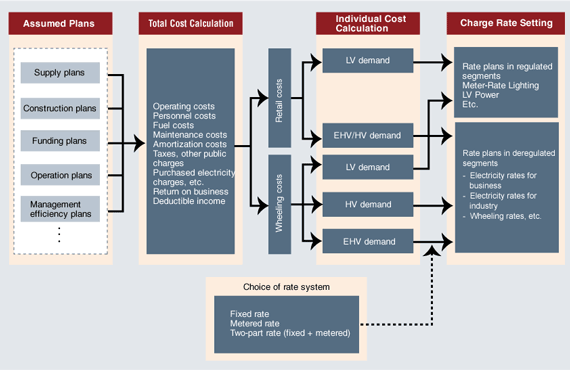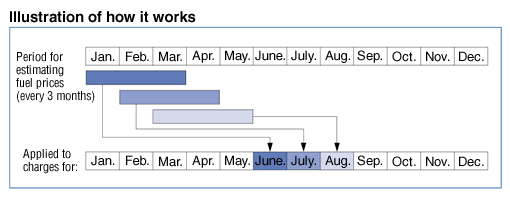Principles of Electricity Rates
Electricity rates in the liberalized segments are decided in negotiations between the supplier (electric power company, Power Producers and Suppliers, etc.) and each user (customer). In the regulated segments, rates are set based on certain rules given in government regulations.
Electricity charges for residential users and other regulated segments are a combination of charges (demand charge + energy use charge) calculated based on total costs, taking into account a future operational rationalization, and a fuel cost adjustment amount. (A solar surcharge is also being added since April 1, 2010.) The fuel cost adjustment amount is reflected in rates periodically, based on fluctuations in fuel prices.
Changes in electricity rates must be approved by the Minister of Economy, Trade and Industry. Ever since 2000, however, rate decreases or other changes that are neutral or beneficial to users require only a simple notification to the ministry.

How rates are set
In setting rates for electricity use, first of all the total costs are calculated based on the supply plan and other factors. Next the distribution of these costs to the demand charge for each segment is decided based on individual cost calculations. Finally, charge rates for each of contract type are decided after reviewing the rate system.
Electricity rates in liberalized segments are negotiated individually. Rules are in place, however, to prevent the General Electric utilities from making up losses in liberalized segments with earnings in regulated segments, or other unfavorable impact on regulated segments power liberalized segments. For example, when an electric power company sets electricity rates in regulated segments, first the required total costs for power supply to all segments are calculated, then the total costs are to be strictly divided and allocated to each segment.

Note 1: In the context of the Electric Utilities Industry Law, Supply Plan should include Construction Plan. Electric power companies (not including Power Producers and Suppliers (PPS) and Specified Electric Utilities) are required under Article 29 of the Electric Utilities Industry Law to submit Supply Plan to the Ministry of Economy, Trade and Industry annually.
Note 2: Okinawa Electric Power Company differs from the above since its liberalizing process is different.
Fuel Cost Adjustment System
How It Works
The fuel cost adjustment system automatically adjusts monthly charges based on fluctuations in actual fuel prices for crude oil, liquefied natural gas (LNG), and coal.
These adjustments are made by comparing the average fuel prices of crude oil, LNG, and coal for three months each (three-month average for five to three months earlier) with a base fuel price (the average price on which rates are currently based), and they reflect the difference in monthly rates.
The average fuel prices are calculated based not on the actual procurement prices of each company but on import fuel prices for Japan as a whole as published by the Ministry of Finance in its trade statistics.

Objectives of the System
The fuel cost adjustment system is designed to externalize the influence of fuel prices and currency exchange rates, which are outside the reach of the management efficiency efforts of electric power companies, in order to make clear the results of such efficiency efforts and reflect changes in the economic situation as quickly as possible, while also helping to stabilize the economic environment for electric power companies.
First introduced in January 1996, the system was revised effective from the May 2009 electricity rates.
















